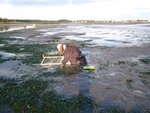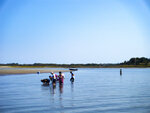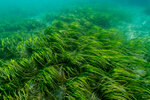


Last week the Cricket ran Part I of Peter Phippen’s article chronicling the efforts of the Great Marsh Coalition to restore healthy eelgrass populations in the Essex Bay. Here’s where we left off:
In 2019, we completed our mission, and the bed was self-supporting and even expanding. Our monitoring of shoot density, canopy height, areal extend, and the number of plants with reproductive shoots showed that we had created a sustainable eelgrass bed. So much so that a year after the final planting we were even considering using the newly established Essex River eelgrass bed as a donor site for future eelgrass restoration projects.
Our success, however, ended abruptly about two years ago. In the early spring, at a negative low tide, we made a trip out to check on the bed after the winter storms had passed, to perform a series of monitoring measurements. The eelgrass bed was in the process of being uprooted, dismantled, and destroyed by a couple of rogue clammers. Despite our call for them to stop, they continued to dig for the razor clams. It was an unusually low negative tide and so the clammers had access to this new territory in the flats, and did they take advantage of it! They knew that the coveted razor clam that they were seeking grew along-side the eelgrass at just below the low tide level. They also knew that the reason there were ANY clams here was a result of the restored eelgrass. We had told them so in previous discussions when we encountered them over the years of planting at low tides.
That knowledge did not impede them from collecting as many market-high priced razor clams as they could. To be fair, it was only two clammers out of dozens of clammers that visit these flats on a near daily basis.
So many man hours, volunteer hours and money wiped out in just a couple of low tide cycles! Authorities at the local, state and federal level were alerted, but it was too late. Very depressing for all those involved. The only small silver lining from this assault was that we noticed seed mussels attaching to the upturned roots (rhizomes) of the dying eelgrass (the blue mussels are still surviving and growing and helping to stabilize the sediments on the small shelf along the Essex River).
It's complicated to explain, but it is a quite difficult and a lengthy process to fully protect eelgrass at the local level. We are working on that, however, in the meantime, we know the parameters needed for eelgrass to thrive do exist at the Essex River site. So, we have pivoted our efforts to plant in deeper water, out of the reach of the clammers. Using divers, we have begun to repopulate the deeper edge of the sandy shelf, below where the mussels and razor clams now subsist, and the clammers can reach. We are also using eelgrass seeds from harvested reproductive shoots that we over-summer in flow through saltwater tanks at the UMass marine facility in Gloucester. With those seeds we are doing a fall seed planting to compliment the newly established deep water eelgrass shoots. The seed planting technique is also being used to infill some struggling eelgrass beds over at the northern end of the Annisquam River in Gloucester.
Hopefully in a couple years I can report back to you on another successful eelgrass meadow along the Essex River!